The Anointing and Plans for Betrayal (14:1–11)
Now the Passover and the Feast of Unleavened Bread were only two days away (14:1). In the time of Jesus, the Festival of the Passover Offering, commemorating God’s redemption of Israel, had become a national holy day celebrated in Jerusalem. The Passover lambs (one-year-old sheep) were slaughtered on the afternoon of Nisan 14 and eaten in a family or fraternal gathering between sunset and midnight, technically the next day, Nisan 15, since the Jewish day was reckoned from sunset to sunset (cf. Gen. 1:5). The Feast of Unleavened Bread is the seven-day feast following Passover, beginning on Nisan 15.312 By avoiding bread with yeast and rejoicing in a feast, those unable to journey to Jerusalem or too poor to purchase a sacrificial lamb for Passover could celebrate the festival of Unleavened Bread. The two festivals had essentially become one in the minds of many.313 Leaven was removed in a ceremonial search of the dwelling on the morning the Passover lambs were sacrificed, and some thought of it as the first day of Unleavened Bread, although technically it began the next day.
The chief priests and the teachers of the law (14:1). The “chief priests” in view here were those permanently employed at the temple as an executive committee, overseeing its daily operations. They include the high priest, the captain of the temple (responsible for the worship), and the temple treasurers. Their wealth and power alienated them from the ordinary priests. “The teachers of the law” (scribes) are those scholars allied with the priestly hierarchy.
“But not during the Feast,” they said, “or the people may riot” (14:2). The fears of the Jewish leaders about a tumult of the people were realistic since Passover was the celebration of the liberation from Egypt, and many viewed it as the prototype of God’s final liberation of Israel. It is estimated that anywhere from 85,000 to 300,000 pilgrims converged on Jerusalem, that normally had a population of 25,000 to 30,000, filling it with the sounds and smells of hordes of people and animals. Most pilgrims slept in tents or boarded in the towns of the surrounding countryside.
The chief priests’ guards had the main responsibility for policing the city, and the Romans had only a small garrison in Jerusalem. Since the atmosphere in Jerusalem was so explosive at this time of year, the Roman governor moved with more troops from his headquarters in Caesarea to Jerusalem to thwart any violent uprisings. In spite of these precautions, Josephus records numerous protests and riots during the Passover season.
The Anointing (14:3–9)
A woman came with an alabaster jar of very expensive perfume, made of pure nard. She broke the jar and poured the perfume on his head (14:3). Jerusalem was filled with a strong smell from the temple sacrifices. If the wind blew from the east, the smoke from the altar turned back not only into the temple courts but over the whole city, bringing a mixture of the horrible reek of burning flesh and the heady smell of incense. Women who could afford it tended to use a great deal of scent, though the rabbis argued in vain that the incense of the temple ought to be enough for a person.314
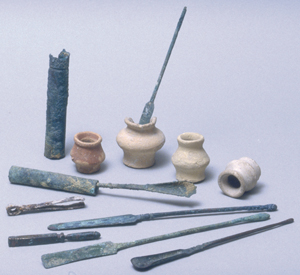
PERFUME JARS
Ointment jars and surgical instruments dating to the Hellenistic era.
Anointing was common at feasts (see Luke 7:46: “You did not put oil on my head”).315 Alabaster jars were made from translucent calcite stone and stood five to nine inches high. A narrow neck restricted the flow of oil or perfume. Breaking the whole jar indicates that its entire contents were used. Nard was a highly valued plant from India. Its value is pegged here at three hundred denarii, which represented almost a year’s wage for a day laborer. According to Mark 6:37, two hundred denarii was sufficient to provide a meal for five thousand people.
A social divide existed between male space and female space in the ancient world. Men and women did not intermingle even in the home. Women only crossed into the public male world to wait on men and then retreated.
The Last Supper (14:12–31)
Judas Iscariot (14:10). See comments on 3:19.
On the first day of the Feast of Unleavened Bread, when it was customary to sacrifice the Passover lamb (14:12). On the eve of Passover, work normally ceased at noon. The ritual slaughter of the Passover lambs began around 3:00 P.M. as the heads of the household brought their animals to the temple.316 The priests sprinkled the blood of the lamb against the base of the altar and offered the fat on the altar. With the legs unbroken and the head still attached to the carcass, it was wrapped in its skin and returned to the worshipers. The forecourt of the temple had been the place to eat the meal, but the large number of people made that now impossible. It was only stipulated that the meal had to be eaten in Jerusalem with a minimum of ten persons. This took place in the evening on Nisan 15—strictly speaking, the first day of Unleavened Bread.
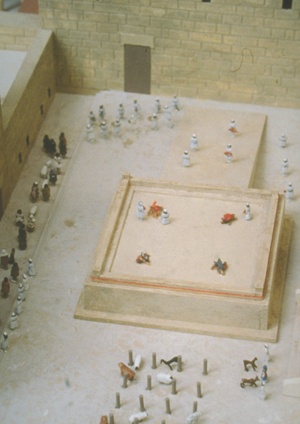
PASSOVER TEMPLE SCENE
A model of the sacrificial altar in the court of priests of the Jerusalem temple.
A man carrying a jar of water will meet you (14:13). Since Jesus probably stays with Simon the Leper in Bethany, his company probably enters Jerusalem either through the Fountain Gate by the Gihon Spring, the Casemate Gate or Water Gate by the King’s Garden, or the Potsherd Gate near the pool of Siloam. It would be usual to spot someone carrying a water jar at any of these gates,317 but it would be unusual to find a man doing so, since women normally fetched water.
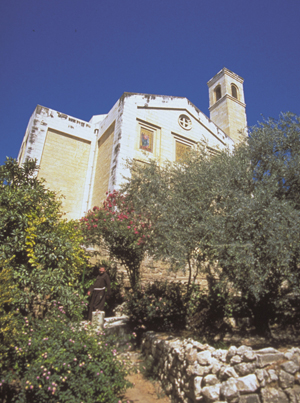
BETHANY
The site of the ancient village of Bethany.
He will show you a large upper room, furnished and ready (14:15). The upper room was “a smaller box on top of a bigger box.”318 It was used as a guest room, storeroom, and a place of retreat; such a room was usually reached by an outside stairway that allowed one to enter it without going through the main room of the house. The sages met their students in upper rooms to teach, according to later rabbinic traditions. This room apparently was furnished with a table that would have been a low U-shaped one. Couches or cushions would have been used for reclining at the meal.
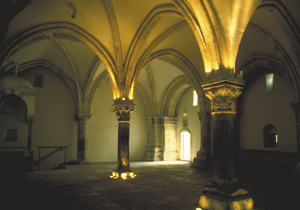
THE UPPER ROOM
A historical tradition locates the last supper in the Cenacle on Mount Zion. This present structure was reconstructed by Franciscans in 1335.
One who dips bread into the bowl with me (14:20). Diners shared from the same dish and used the bread as their utensil. In this culture, eating bread with someone barred one from hostile acts against a fellow eater (see Ps. 41:9). In The Sentences of the Syriac Menander 2.215–16 we find this admonition: “And he with whom you had a meal, do not walk with him in a treacherous way.”
While they were eating, Jesus took bread, gave thanks and broke it, and gave it to his disciples, saying, “Take it; this is my body” (14:22). The visible union between Jesus and his disciples will dissolve at his death, but he provides a symbol by which it is to be replaced by an invisible one. He gives a special interpretation of the shared loaf and the shared wine, linked to the familiar rite of pronouncing a blessing before a meal. At every meal, the head of the family took the bread, lifted it up, and said, “Praise be Thou, O Lord our God, King of the Universe, who causes bread to come forth from the earth.” After the “Amen” response, the bread was broken and distributed, mediating the blessing to each one who ate. Jesus gives the traditional blessing of the bread a new twist by saying that it is his body.
Then he took the cup (14:23). The Book of Jubilees provides evidence for the association of wine with the Passover festival (Jub. 49:6). Wine was always diluted with at least three parts water to one part wine (2 Macc. 15:39).
They all drank from it (14:23). Jesus uses the suggestive symbolism of the wine as the blood of the grape, plucked from the vine and crushed. Drinking the cup of someone was understood as a means of entering into a communion relationship with that person to the point that one shared that person’s destiny, for good or ill (see Ps. 16:4–5).
I tell you the truth, I will not drink again of the fruit of the vine until that day when I drink it anew in the kingdom of God (14:25). “Not drinking again” becomes a metaphor for death.319 With this statement, Jesus again prophesies his death. He will die before he will join in another festive banquet.320 “Drinking again” is a metaphor for God’s saving action when his kingdom comes.
When they had sung a hymn, they went out to the Mount of Olives (14:26). We should not immediately associate this hymn with the Hallel Psalms sung at Passover. The Passover rituals known to us from the Mishnah developed after the destruction of the temple when it no longer was a pilgrimage feast. Before then, the Passover practices were not uniform; and these later traditions may not have been the custom in Jesus’ day. The hymn may simply convey the “prayerful context as the meal closed.”321
Tonight—before the rooster crows twice (14:30). The cock’s crow may refer to a real rooster crowing or to the bugle call of the gallicinium (cockcrow) that signaled the third watch of the night in Roman military reckoning (from 12:00 to 3:00 A.M.). The two cockcrows may refer to the signals at the beginning and the end of that watch. The text, however, lacks the definite article before the word for rooster, and this absence suggests that Mark understands it to refer to a fowl rather than a night watch.
Rabbinic evidence conflicts on whether one was allowed to raise poultry in the city of Jerusalem. A tradition from the Mishnah forbids it;322 a tradition from the Jerusalem Talmud assumes their presence in the city.323 Whether or not this conflicting testimony is relevant for the first century, a rooster would not need to have been within the walls of Jerusalem to have been heard.
The second cockcrow was connected to the dawn or rising sun.324 Jesus’ statement essentially means “before the next dawn.”325
| Contrasts Between Passover and the Lord’s Supper | |
|---|---|
|
Passover |
Lord’s Supper |
|
In the old age of law |
In the new age of the kingdom |
|
The great festival meal celebrating the birth of God’s people |
The new celebratory meal of the birth of God’s people |
|
Participants associate themselves with deliverance and the old covenant |
Participants associate themselves with redemption and the new covenant |
|
Looks back to the Exodus and forward to God’s salvation |
Looks back to the cross and forward to the consummation |
Prayer in Gethsemane (14:32–52)
They went to a place called Gethsemane (14:32). The word Gethsemane comes from a Hebrew/Aramaic word (Gatz šemānî), meaning “oil press.” Mark does not identify it as a garden (John 18:1) but simply as a “place”; four different locations on the Mount of Olives claim the honor of being the authentic site. Taylor contends that Gethsemane does not refer to an olive grove but to a spacious cave (about 55 feet long and 29–1/2 feet wide) within a cultivated enclosure, adjacent to the Church of All Nations, where olives were pressed for oil.326 The press would have been in operation in the fall and winter after the olive harvest but would have been idle and used only for storage in the spring. Such a locale, close to the city, would have made an excellent place to spend a chilly night that had others kindling fires for warmth (14:54). It would have been “warm, dry, and roomy, with a cistern inside for water.”327 This location may explain why the young man there is attired only in a linen garment (14:51–52) as he presumably sleeps on his cloak. In the shelter of the cave, such a decision is understandable; out in the open, exposed to frigid air, it is not. Jesus may have left the cave to go further away in the enclosure to pray by himself.
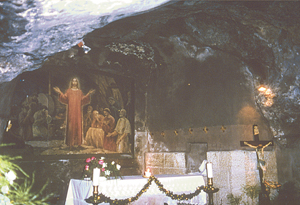
ALTAR IN CAVE IN GETHSEMANE
Taylor cites as the earliest evidence for its location Egeria’s account of her pilgrimage to the Holy Land. She said that pilgrims go “into Gethsemane” and are given candles “so that all can see.” Theodosius, in the sixth century, explicitly identifies it as a cave.328
He fell to the ground and prayed that if possible the hour might pass from him (14:35). The normal Jewish attitude of prayer was to lift one’s hands toward heaven and to pray aloud while standing. When one was in particular distress, one prayed lying prostrate. Jesus prostrates himself before his Father to pray in the same way that others in Mark’s story fell before him to make their requests (5:22; 7:25).
Jewish prayers are sometimes remarkable for their loud complaint and directness. They approach God as a trusting child does, willing to complain bitterly and ask for anything. These prayers may seem insolent to us, but they reveal an intimacy with God, who is believed to listen sympathetically and grant requests.329 Jesus’ prayer conforms to this tradition. He trusts completely in God as his Father and is obedient.
Abba, Father (14:36). “Abba” is the Aramaic word term for father, and there is “no evidence in the literature of pre-Christian or first-century Palestinian Judaism that ‘abbā’ was used in any sense as a personal address for God by an individual.”330 This unusual way of addressing God was remembered by Jesus’ followers because his disciples also experienced such closeness to God in prayer through the Spirit (Rom. 8:15; Gal. 4:6). The term does not mean, “Daddy,” however.331 In translating it for Greek readers, Mark uses the regular word for “father” (patēr), not a diminutive form. The word was used both by children for their father and by disciples for an esteemed teacher. While the address may exhibit intimacy, it is not flippant. As Father, God requires obedience.
Now the betrayer had arranged a signal with them: “The one I kiss is the man” (14:44). One normally greeted a teacher or rabbi with a kiss on the hand or cheek if one considered oneself to be an equal (see Luke 7:45, “You did not give me a kiss”). See the parting kiss given to Paul by the Ephesian elders (Acts 20:37). Judas addresses him as rabbi and kisses him (Mark 14:45). He may have kissed him affectionately (the same word appears in Luke 15:20) or on the hand or even the foot (Luke 7:38, 45). The customary greeting of respect is turned into a sign of infamy and death.
Am I leading a rebellion … that you have come out with swords and clubs to capture me? (14:48). The high priests paid Judas to lead them to Jesus where they can quietly arrest him without a skirmish, yet they come ready for combat. The question, “Am I leading a rebellion?” interprets the Greek phrase, “Have you come out against a robber?” Josephus uses the term “robber” for the social bandits that badgered the aristocracy. He “never uses the term lēstēs to describe a revolutionary against Rome.”332 These bandits were usually peasants driven from their land. In response to injustice, they chose outlawry rather than meek submission and preyed on the rich in the countryside. Galilee was famous as a haven for bandits; Josephus notes their “habitual malpractices, theft, robbery, and rapine.”333
Yet Mark is writing in a time during or shortly after the Jewish revolt against Rome. He may intend for readers to see the clear contrast between Jesus and contemporary assassins and revolutionaries.
A young man, wearing nothing but a linen garment, was following Jesus (14:51). This man apparently was sleeping in his undergarment, a linen cloth, and attempts to follow along with Jesus. When the arresting posse tries to seize him, he wriggles free from their grasp, fleeing into the darkness naked (presumably with only his loin cloth).
The young man is unidentified. Some, appealing to John 18:15, identify him as “[the other] disciple” known to the high priest, perhaps John, son of Zebedee. Others have guessed it is Mark himself, whose mother Mary has a house in Jerusalem (Acts 12:12). Remembering his disgrace, Mark gives himself a cameo role in his Gospel. It is more likely, however, that this anonymous figure epitomizes the “save yourself if you can” mentality that causes all the disciples to desert Jesus in a panic. Unprepared for testing, they break down completely, just as Jesus prophesied they would (Mark 14:27). The last remnant of their respectability is stripped away.
The Sanhedrin Hearing (14:53–65)
They took Jesus to the high priest (14:53). We learn from Acts 4:6 that the high priest was Joseph Caiaphas, the son-in-law of Annas (who held the office from A.D. 6 until he was deposed in A.D. 15). Annas remained a kind of godfather controlling the reins of power with five sons holding the office of high priest.334 The clan of Annas is remembered in the Babylonian Talmud for its knavery: “Woe unto me because of the house of Hanin [Annas], woe unto me because of their whisperings.”335 Josephus refers to the son of Annas, Ananas II (high priest in A.D. 62), as following the school of the Sadducees, who were “more heartless than any of the other Jews … when they sit in judgment.”336
Pilate’s predecessor, Valerius Gratus, removed four high priests during his eleven-year tenure as governor. Caiaphas had to be an artful politician to have held office as high priest for eighteen years from A.D. 18 to 36, serving throughout Pilate’s tenure.337 The family tomb of Caiaphas has been discovered. The name of Joseph bar Caiaphas is inscribed in Aramaic (Yhwsp br Qp’) on an elaborately decorated bone box containing the bones of a sixty-year-old man.338
We do not know where the high priest’s home was. Some suggest it was located on the old Hasmonean palace on the West Hill of Jerusalem that “stood above the Xystus on the opposite side of the upper town.”339 Others claim it was near the Zion Gate in the southern section of the Western Hill.
The chief priests, elders and teachers of the law came together (14:53). In addition to the chief priests (see comments on 14:1), this group may also include the leader of the weekly course of priests and the leaders of the daily courses of priests. The elders are likely the heads of the distinguished families who are not priests but are aligned with the governing priestly faction. They are distinct from the elders who were the scholars behind “the tradition of the elders” (7:5).
The chief priests and the whole Sanhedrin (14:55). The Mishnah identifies the Great Sanhedrin as consisting of seventy-one members (see Num. 11:16).340 The Mishnah, however, is not a reliable source for understanding how this body functioned in the first century or the juridical procedure against Jesus. The term sanhedrin can denote any council (see Mark 13:9, “councils,” lit., “sanhedrins”). Rather than referring to a fixed body of members suddenly called into session in the middle of the night, it is more likely an ad hoc group of powerful noblemen, a sanhedrin of judges, whom the high priest assembles for an inquest to prepare charges before Pilate.
The Jewish people did not have the right to administer capital punishment at this time (John 18:31). The Jerusalem Talmud states: “Forty years before the destruction of the Temple, the right to judge capital cases was withdrawn.”341 It was the most jealously guarded of all the attributes of government. According to Josephus, the high priest Ananus was deposed for convening a Sanhedrin that condemned James, the brother of Jesus, to death during a transition from one governor to the next; he was accused of acting without the governor’s permission.342 The Sanhedrin gathered to judge Jesus, therefore, cannot pronounce a real death sentence because only Pilate, the governor, can carry out the death penalty after reaching his own verdict. He is not a rubber stamp and can overrule whatever they decide.
I will destroy this man-made temple and in three days will build another, not made by man. (14:58). Mark describes this as false testimony, and it is difficult to identify precisely how it is false. Possibly, the Jewish leaders wish to paint Jesus as a dangerous crank. Josephus describes the false Egyptian prophet gathering followers on the Mount of Olives and promising that at his command the walls of Jerusalem will fall down.343 They may want to associate this boast with Jesus’ claim to be the Messiah. Since 2 Samuel 7:13 mentions that David’s offspring will build a house for God’s name, some may have assumed that one of the tasks of the coming Messiah was to rebuild the temple (see Zech. 6:12–13). The Targum to Isaiah 53:5 reads: “But he shall build the sanctuary that was polluted because of our transgressions and given up because of our iniquities….”344
“Without human hands” (NIV “not made by man”; cf. Dan. 2:34, 45) means not of human origin. It will be a spiritual sanctuary.345
The high priest tore his clothes (14:63). Tearing one’s garments was an ancient way of expressing distress and mourning.346 The gesture is a fitting response to blasphemy and a dramatic way of getting the others to agree with him.
You have heard the blasphemy (14:64). According to Mishnah Sanhedrin 7:5, “ ‘The blasphemer’ is not culpable unless he pronounces the Name itself” (see Lev. 24:16). Measured by this rule, Jesus is not technically guilty. This ruling may not have been operative in Jesus’ time, and what people regard as sacrilege need not fit any technical definition. Jesus’ admission that he is the Messiah supposedly infringes on God’s prerogative to declare who the Messiah is and to enthrone him.
Jesus’ answer that the Son of Man will be sitting at the right hand of God in power also implies that he is on the same level with God. The Talmud records a dispute in which Rabbi Akiba interprets the phrase in Daniel 7:9, “till thrones were placed,” as referring to two thrones, one for God and one for David (the Messiah), so that “one like a son of man is identified as the royal Messiah.” His colleagues vigorously reject this interpretation as profaning the Divine Presence.347
A text from Qumran refers to the last enemy of God calling himself the son of the Most High and demanding adoration and obedience.348 Flusser calls it “important evidence for a Jewish tradition about the superhuman hubris of the Antichrist.”349 Jesus’ assertion perhaps confirms the high priest’s suspicions that Jesus is a figure like this who tries to seduce the world.
In his summary of the Jewish law, Josephus freely renders Leviticus 24:16: “Let him that blasphemeth God be stoned, then hung for a day, and buried ignominiously and in obscurity.”350 The high priest may not be able to stone Jesus, but he has every intention that Jesus be put to death and suffer the humiliation of being hanged and given a dishonorable burial.
Then some began to spit at him; they blindfolded him, struck him with their fists, and said, “Prophesy!” (14:65). The taunt to prophesy derives from Jesus’ implicit claim to be the Messiah, who was supposed to have a prophetic gift. According to an anecdote in the Babylonian Talmud, the Messiah is able to judge by smell:
Bar Koziba [“son of lies,” see comments on 13:6] reigned two and a half years, then said to the rabbis, “I am the messiah.” They answered, “Of the messiah it is written that he smells and judges; let us see whether he can do so.” When they saw that he was unable to judge by scent, they slew him.351
The torturers may also be playing a cruel version of the game of blindman’s bluff, known from this era, where the person must guess who is hitting him.352
Peter’s Denial (14:66–72)
While Peter was below in the courtyard (14:66). Peter’s denial of Jesus wraps around the trial of Jesus, indicating that they both take place at the same time. While Jesus is interrogated by the high priest, Peter waits in the courtyard (though the word aulē may refer to a court in the house). The courtyard was the open space around which rooms were arranged; the “entryway” (14:68) was the vestibule leading to the courtyard.
Surely you are one of them, for you are a Galilean (14:70). In rabbinic literature, Galileans are portrayed as simpletons and riffraff (see the prejudice reflected in John 7:45–52). They can be identified by their Aramaic accents (Matt. 26:73). Jerusalem merchants taunt a Galilean wanting to purchase an amar:
“Foolish Galilean,” they said to him, “do you mean an ‘ass’ for riding [hamār], ‘wine’ to drink [hamar], ‘wool’ for clothing [ʿamar] or a ‘lamb’ for killing [immar]?”353
Vermes explains with an example from modern British English: “In careless everyday conversation the Galileans dropped their aitches.”354
He began to call down curses on himself (14:71). The text does not say that Peter called down curses on himself. The verb has no object in the Greek text, and it is possible to construe it that he goes so far as to curse Jesus. Pliny the Younger was appointed by the emperor Trajan to govern Bithynia-Pontus and reported that he asked suspected Christians three times with threats of punishment, “Are you a Christian?”355 The accused proved their innocence by cursing Jesus, which, he says, “those who are really Christians cannot be made to do.”356 In the Martyrdom of Polycarp 9:3, the proconsul adjures Polycarp, “Swear and I will release you.” Polycarp replies, “How can I blaspheme the King who saved me?”
